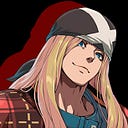Pole vector constraints are used almost exclusively in pairs with IK handles. You can think of it controlling where the bend/elbow/knee IK points to. This article is meant to be read after the guide to set up IK handles.
Note that this guide requires understanding of setting up animation controls. Pole Vector constraints are not a part of the rig.
Official Documentation: Pole Vector constraints | Maya | Autodesk Knowledge Network
Where is this tool:
rigging menu→ Constrain →Pole Vector
How to Use:
The pole vector constraint requires two things: an object to constrain to (what you will use to control the bend, aka the controller), and an IK handle that it is controlling.
- Start by creating the controller. Here we are using a NURBS curve as it’s the standard for animation controls. You can use a simpler shape like a circle, I’m using a pyramid here because it’s easier to see.
2. Position the controller onto approximately where the bend joint is (or if your IK is controlling multiple joints, approximately where the middle between the start and end joint). You can do it in the same way we set up controls, or for simply turn on snap to point, and then snap your NURBS curve to the center of the joint.
3. Offset/move the controller for some distance in the current bend direction(pole vector)of the IK. You can see the pole vector indicated by the white arrow when you select an IK. If your IK is not bending in the way you want it to, you can reference this guide.
Note: Step 2–3 doesn’t have to be done to great precision, this is just to make the controls more intuitive to use later :)
4. Now is the step which we make the constraint. First select the controller, then select the IK handle, and then click Pole Vector Constrain. You should see something like this.
Now you’re done! Move the IK and the Pole Vector Constraint Controller (the pyramid, or whatever shape you used)around to see the result.
